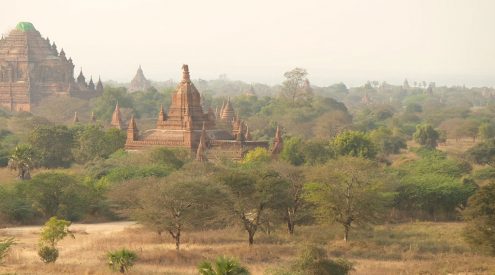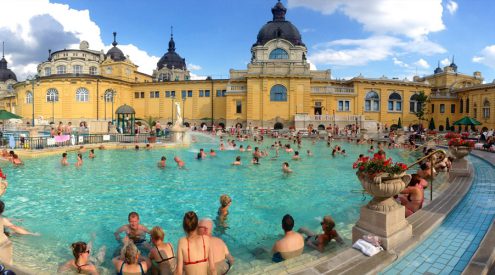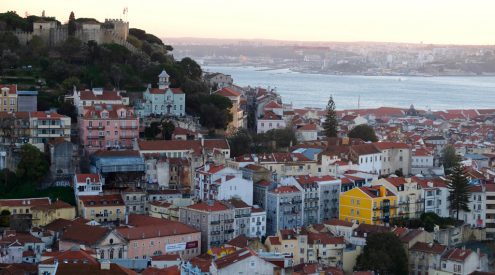The Swiss obsession is not chocolate. It’s locomotion. Even as the world pinches its coffers, Switzerland continues to build a railway network that, if laid end to end, could run the length of a tunnel between the earth’s poles, twice. For its residents, there is nowhere easier in the world to move around. For visitors, the hyper-reality of mainlining postcard-perfect towns has a side effect. One that’s not altogether bad.

On top of Diavolezza, the first dustings of the coming winter snow settle into the high ridges and crevices. Photo by Tyson Jopson.
There are a handful of great train voyages in the world that everyone wants to do at least once, like leave a dreary London behind on the Venice Simplon-Orient-Express; channel Wes Andersen on the Darjeeling Himalayan Railway; or keep a diary on The Blue Train. Then there is the Trans-Siberian Express, The Hiram Bingham to Macchu Picchu, The Ghan across the Outback. I’ve yet to meet someone who doesn’t want to experience these iron triumphs.
Read: 10 reasons to travel Europe by train
Somehow I had bamboozled my way onto one of them: a four-day journey through Switzerland on a trifecta of world-renowned Alpine express lines. I wasn’t alone. I was travelling with the esteemed Kate Turkington, long-standing SA radio personality with a legacy as formidable as her wit; Brendan Seery, The Saturday Star’s no-bullshit newsman; and Dawn Jorgensen, earth advocate and blogger at The Incidental Tourist. We’d even been appointed a fearless leader (as fearless as one need be in the safest country in the world). He was Axel Simon, our Swiss International Airlines point man with a penchant for pepper (he’s been rumoured to sprinkle it on everything, even gelato). I couldn’t have asked for better company.
The five of us took The Three City Line east out of Zurich, hugging the edges of Zurichsee like the seam of a dress. At Chur, we boarded the Bernina Express and the world changed. We snaked through tunnels and across viaducts, left and right, green seas of pine rose up until they were blocked by the sheer, hard faces of the Alps’ upper peaks. We sped along to St. Moritz, ice-cold but so high that it’s always sunny. The following day we plummeted south into Italy, where it was so warm they were eating pizza on the streets. We briefly swapped iron for rubber and careened along on narrow lanes above Lake Como in a crowded Bernina Express bus. Our driver didn’t seem to notice that the lanes were laid out before buses were invented. He straddled the centre line and honked incessantly, bewildered that cars should dare approach from the opposite direction. At one point my backpack succumbed to the wild steering and shot out of the overhead rack, almost wounding an elderly, already terrified passenger.
‘We must be making time,’ I thought, picturing the driver as an Italian version of Richard E. Grant in Withnail and I, trying desperately to keep his leg of the journey in time with the absurdly efficient Swiss timetable. See, being on time is very serious business in Switzerland. But so is going on holiday. ‘Hurry up so that you can relax’. To you and I it may seem a paradox. To the Swiss it’s simply efficient holidaying – and that’s exactly what we were doing.
In just four days, we’d gone from Alpine, ski-paradises like Diavolezza to café-living in cobbled towns of Ticino, Switzerland’s Southernmost, expressly Italian, canton. We’d hiked (and got lost on) the slopes of Cardada, explored Locarno and the faux-French Rivieria of Ascona. The landscape had changed from snow-capped peaks with opaque, turquoise blue mountain lakes to pastel-coloured houses with wooden shutters and back again. We took the Glacier Express north. It’s an immaculate railway line that cuts through Alpine bedrock, spirals up inside mountain tunnels before emerging to cross bridges and viaducts hundreds of metres above towns just passed. We moved effortlessly past lonely station towns and I felt a pang of guilt for meeting them each so informally. Nothing can flatten the Alps quite like the Swiss Federal Railway. But then again, nothing has become so much a part of its landscape. A Swiss train is not a vehicle. It’s a place.
On the fourth day we swooped into Flüelen, hopped on a 100-year-old steamer and crossed the Vierwaldstätter See so that we could take a stroll in Lucerne. A few hours later we were back in Zurich, ready to board a flight home. We’d seen more than I had in a week of travel anywhere else. Fleeting, sure, but the rhythm of rail – fast metal clacks scooping over rails at speed – somehow shuffles it all into a palpable tempo. It offers the freedom of distraction while still moving forward and anyone who cares to write, walk around, eat, or even sleep (and I did) can do so. It’s a moving window – not so fast as to blur perception, but just enough to enhance the view and, even, aggrandize the places it traverses. The side effect? It makes you feel like you have a lot of time. As long as you’re also on time.
Here are some of the photos I took along the way.

Heading out from Zurich to St Moritz alone, the Swiss Railway Network (SBB) takes you through more than 80 tunnels and twice as many bridges.

Aboard the Bernina Express, postcard towns pop up between thick blankets of green.


The view from Muottas Muragl, near the town of St. Moritz.

At just under 3 000 metres, Diavolezza – ‘The Beautiful She Devil’ is one of the most popular skiing destinations in the Upper Engadin. It’s seasonal, and though the slopes only open after heavy snowfall at the end of November, off season visitors and locals alike content themselves with hiking along the skeletal ridges and glacial divides.


Behind the Berghaus Diavolezza, 3 000 metres up in the Swiss Alps, the first pack snow of the season begins to coat the inky summer peaks.

While most opt to take the Bernina Diavolezza Gondola up Diavolezza, in the summer months its possible to hike from the base of this eponymous mountain all the way to the ski slope at the top.

Set a few kilometres north of the highest peak in the Eastern Alps (the Piz Bernina), St. Moritz boasts more than 300 days of sunshine a year, making it a favourite winter holiday spot for Europe’s elite.

For three months a year, Mortitzersee (Lake St. Moritz) is frozen over and 30 cms of pack ice hold up the clattering of hooves during horse-drawn winter sports.

Sunbathers on Lake Como, Italy, eek out the last of the summer rays before temperatures drop around this, the third largest, and widely regarded as the one of the most beautiful lakes in Europe.

With its soft pastel-coloured buildings, bright shutters and cobbled streets, Bellinzona, while formally Swiss, is a slice of Italy tucked between the Southern Alps.

There’s a sidewalk cafe on almost every corner in Bellinzona.

At the foot of the Alps, the small town of Bellinzona, famous for its three castles (Castelgrande, Montebello, Sasso Corbaro), slowly stirs into life as the church bells hail the hour.

Locarno by day, Bellinzona by night.

The Sanctuary of Madonna del Sasso in Orselina is a funicular ride up from the town of Locarno and provides a great view of the town and lake below.

By combination of funicular and gondola, visitors to Cardada, above the Italian Swiss town of Locarno can take in the view of Locarno and Lake Maggiore below.

From the protruded viewing deck on Cardada Cimetta you can see both the highest (Monta Rosa) and lowest (Lake Maggiore) point in Switzerland.

Every summer more than 8 000 people converge on the Piazza Grande in Locarno for one of the largest, open-air festivals in the world. For the rest of the year, the piazza is a spotless nucleus that joins the old town to the new in a string of sidewalk cafes and stores.

Photo by Tyson Jopson.

Photo by Tyson Jopson.

Table tennis at Capanna La Stallone, Cardada.

Locarno, Switzerland.

Town and country.

With Lake Maggiore on its doorstep, Ascona’s narrow, cobbled streets, brightly coloured buildings and surprising palm trees looks as if its been transplanted directly from the edge of the Mediterranean.

Ascona.

View from the Glacier Express, Switzerland.

Switzerland is, without a doubt, best explore by rail.

The 100-year-old paddle steamer ‘Uri’ makes its daily voyage from Flüelen to Lucerne and back, a 3-hour boat ride through some of Switzerland’s most breathtaking scenery.

Crossing the Vierwaldstätter See (commonly known as Lake Lucerne) on a 100-year-old paddle steamer.

Lunch inside the Paddle Steamer ‘Uri’ on Lake Lucerne.

Lake Lucerne.

Lake Lucerne.

The Kapellbrücke (Chapel Bridge) which spans the Reuss River in Lucerne is the oldest wooden bridge in Europe and a spectacular spot to take in the city around you.
Travel information
I was hosted by SWISS International Airlines, who offer daily return flights from Johannesburg to Zurich from R11 000.
I used a Swiss Pass (www.swiss-pass.ch) which allows unlimited travel on consecutive days on national and most private networks. It costs approximately R2 000 for four days (prices vary and there are often last-minute discounts and specials). Alternatively, a Swiss Flexi Pass gives unlimited rail travel for non-consecutive days in a month.


















